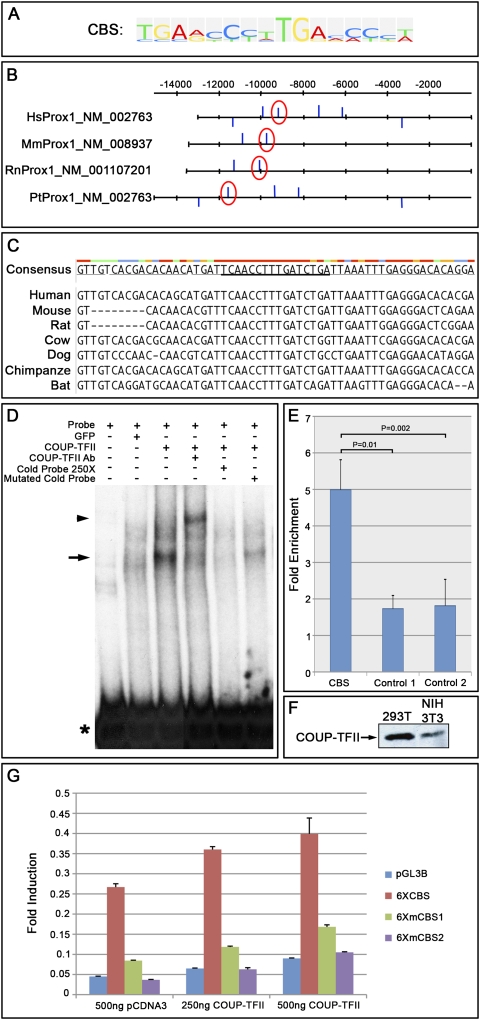Figure 2.
Coup-TFII binds directly to a conserved site present in the Prox1 upstream regulatory region. (A) Coup-TFII recognizes a 16-nt motif (CBS) that consists of two similar 8-nt repeats. (B) A DNA region located 5 kb upstream of the noncoding exon 1 and the entire intron 1 (upstream of the ATG translational start codon) of human (Hs), mouse (Mm), rat (Rn), and chimpanzee (Pt) Prox1 was analyzed, and putative CBSs were identified (blue bars). Upward bars indicate those in the sense orientation, and downward bars indicate those in the antisense orientation. Red circles highlight the CBS that is conserved among all species tested. (C) The identified CBS is also conserved among other mammals whose DNA sequences are available. The consensus DNA sequence is underlined. The colors above the nucleotides indicate the consensus strength, with red being the strongest and blue being the weakest. (D) The conserved CBS from the mouse Prox1 gene was amplified by PCR, and the radiolabeled probe was generated using 32P-dCTP. EMSA was performed using 293T cell lysates with or without ectopically expressed COUP-TFII. (Lane 1) Probe alone (asterisk). (Lane 2) Labeled probe incubated with GFP-transfected 293T cell lysate. (Lane 3) Labeled probe incubated with COUP-TFII-transfected 293T cell lysate. The shift in the mobility of the probe is seen (arrow). (Lane 4) Probe incubated with COUP-TFII-transfected 293T cell lysate and a mouse monoclonal antibody against COUP-TFII. A supershifted band (arrowhead) can be seen. (Lane 5) An excess (250-fold) of nonradiolabeled probe efficiently competed with the binding of COUP-TFII to the radiolabeled probe. (Lane 6) Replacement of the two highly conserved TG residues by AA residues in the nonradiolabeled probe reduced this competition. (E) ChIP was performed on human LECs maintained in culture by using a rabbit polyclonal antibody against COUP-TFII. Real-time PCR was carried out using the pulled-down DNA fragment as a template and primers and probes specific for the conserved CBS, a nonconserved CBS (control 1), or a nonspecific site 40 kb downstream from the ATG (control 2). When compared with controls, a statistically significant (P ≤ 0.01) enrichment was observed for the conserved CBS. (F) Western blotting shows the expression of COUP-TFII in 293T and NIH 3T3 cells commonly used for luciferase assays. (G) Dual luciferase assay was carried out using the generated reporters containing six consecutive conserved CBSs that are wild-type (6XCBS), carrying a mutation in 4 of the 16 nt (6XmCBS1), or carrying a mutation in 8 of the 16 nt (6XmCBS2). The 6XCBS showed endogenous activity caused by the presence of COUP-TFII in the cells. This activity increased with increasing concentrations of the COUP-TFII expression plasmid. Although the 6XmCBS1 showed reduced endogenous activity, it moderately responded to ectopic COUP-TFII. The 6XmCBS2 did not show any endogenous activity and did not respond to COUP-TFII.

